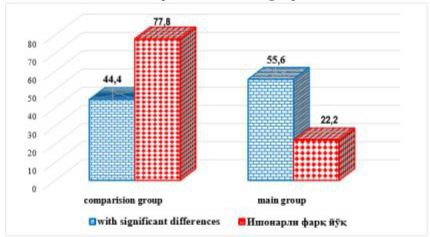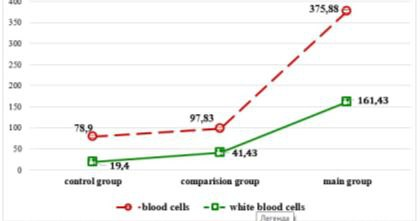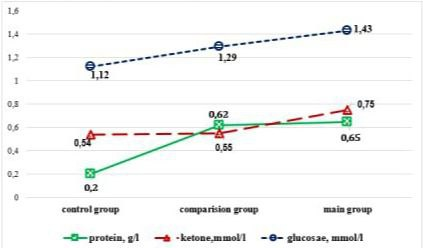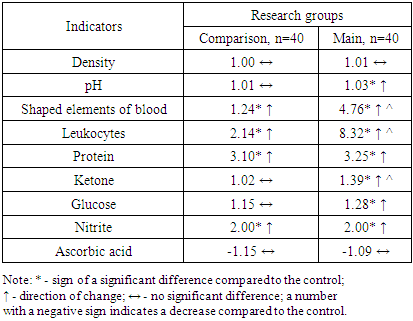-
Paper Information
- Next Paper
- Previous Paper
- Paper Submission
-
Journal Information
- About This Journal
- Editorial Board
- Current Issue
- Archive
- Author Guidelines
- Contact Us
American Journal of Medicine and Medical Sciences
p-ISSN: 2165-901X e-ISSN: 2165-9036
2025; 15(6): 1776-1781
doi:10.5923/j.ajmms.20251506.29
Received: May 2, 2025; Accepted: May 28, 2025; Published: Jun. 7, 2025

Study of Oral Fluid Composition of Children in Recurrent Herpetic Stomatits Diagnostic Value
Nuraliev Nekkadam Abdullayevich1, Razikova Dilnoza Kadyrovna2
1Professor, Bukhara State Medical Institute, Bukhara, Uzbekistan
2PhD, Bukhara State Medical Institute, Bukhara, Uzbekistan
Correspondence to: Nuraliev Nekkadam Abdullayevich, Professor, Bukhara State Medical Institute, Bukhara, Uzbekistan.
| Email: |  |
Copyright © 2025 The Author(s). Published by Scientific & Academic Publishing.
This work is licensed under the Creative Commons Attribution International License (CC BY).
http://creativecommons.org/licenses/by/4.0/

Introduction: dental health is one of the important aspects of maintaining the health of the population today and is an important factor in improving the quality of life of people. It is known that dental diseases occupy a leading position among common diseases, especially when changes in the organs and tissues of the oral cavity under the influence of various somatic diseases are characterized as factors that disrupt dental health. Results: 120 children aged 1 to 7 years were involved in the study, their oral fluid was taken using a traditional method, this method allows studying the composition of biological fluid, assessing the condition of the mucous membrane of the oral cavity. Conclusion: In the oral fluid of children diagnosed with recurrent herpetic stomatitis, blood formed elements were detected 1.24 times more, nitrites 2.0 times, and protein concentration 3.10 times more than in healthy people. These changes were characterized by damage to the oral mucosa and periodontal tissues in recurrent herpetic stomatitis, a specific mechanism of action of the causative herpes simplex virus, the development of the inflammatory process, and increased local immunity of the oral fluid.
Keywords: Relapsing herpetic stomatitis, Children's oral fluid, Immunomodulators, Quality of life, Diagnostic analysis
Cite this paper: Nuraliev Nekkadam Abdullayevich, Razikova Dilnoza Kadyrovna, Study of Oral Fluid Composition of Children in Recurrent Herpetic Stomatits Diagnostic Value, American Journal of Medicine and Medical Sciences, Vol. 15 No. 6, 2025, pp. 1776-1781. doi: 10.5923/j.ajmms.20251506.29.
Article Outline
1. Introduction
- Dental health is one of the most important aspects of maintaining public health today and is considered an important factor in improving the quality of life of people. As is known, dental diseases occupy a leading position among common diseases, especially changes in the organs and tissues of the oral cavity under the influence of various somatic diseases are characterized as factors that impair dental health [1].Herpes simplex virus (HSV) is a common viral infection in humans, affecting 75-90% of the population. According to the World Health Organization (WHO), by the age of 5 (usually between 6 months and 3 years), 67% of children worldwide are infected with the virus. This age period is associated with a decrease in the concentration of maternal antibodies and the formation of the child's own immune system [2,3,4].Studies show that up to 90% of children are infected with the Herpes Simplex virus at an early age . The oral mucosa is a common location for herpetic eruptions. The pathological process in the oral mucosa (herpetic stomatitis) can be limited or widespread [5].According to Muller R. et al. [2021], in countries with a high level of hygiene, primary herpetic stomatitis is often accompanied by pronounced clinical symptoms. At the same time, in countries with a low level of hygiene, the disease often has a mild course, which is associated with early infection and adaptation of the immune system. Primary herpetic stomatitis is accompanied by fever, painful rashes on the oral mucosa and loss of appetite, in 60-70% of cases the primary episode proceeds acutely, with a rise in body temperature to 39-40°C. The clinical picture depends on the age of the child and the state of his immune system [6,7].Dysfunction of the immune system is manifested by a decrease in the resistance of children to infectious agents, a decrease in the activity of this system. In patients with a history of severe atopy, foci of the infectious process are often exacerbated. In moderate and severe cases of the disease, secondary immunodeficiency in all parts of the immune system against the background of suppression of the T-cell regulatory system leads to the development of an autoimmune component [Gurina O.P. et al., 2016].Based on this, the purpose of the study was to evaluate the diagnostic value of the study of the composition of the oral fluid of children with recurrent herpetic stomatitis.
2. Methodology
- 120 children aged 1 to 7 years were involved in the study, their oral fluid was taken using a traditional method, this method allows studying the composition of biological fluid, assessing the condition of the mucous membrane of the oral cavity.For this purpose, “Qihgdao Hightop Biotech Co.Ltd” (Qingdao, China) test strips were used. The test strip allowed the detection of 9 parameters in oral fluid, which was immersed in this biological fluid for 5-10 seconds, then removed and held on its side for 5 seconds, preventing the mixing of chemicals in each colored block. The test strip was then compared with the diagram on its container from bottom to top, and the time for each test was also calculated.All obtained numbers are compared with a color reference scale, and the results are recorded. The time limits for obtaining each test are as follows: leukocytes 2 min, nitrite 60 sec, protein 60 sec, pH 60 sec, presence of blood elements 60 sec, ketones 40 sec, glucose 30 sec.All studied children were divided into the following groups: control group - healthy children without allergic and dental diseases, n=40; comparison group - sick children diagnosed with recurrent herpetic stomatitis, but without allergic diseases, n=40; main group - sick children with concomitant recurrent herpetic stomatitis and allergic diseases, n=40.Statistical processing of the obtained results was carried out with the help of a special program for medical-biological research using traditional variational statistical methods.
3. Results
- The above parameters were determined and comparatively analyzed in the oral fluid of children with recurrent herpetic stomatitis (comparison group, n=40).The results showed that there were no significant differences in the density and pH of oral fluid - 6.37±0.06 versus 1.03±0.01 units and pH 6.29±0.04, respectively (P>0.05). Although there was a tendency for the hydrogen index to increase towards a neutral environment, no significant differences were found in the results. This suggests that herpetic stomatitis, which developed in the oral cavity, did not change the density of oral fluid and did not affect its pH.A similar lack of significant difference was observed in the determination of ketone bodies – 0.54±0.04 mmol/l versus 0.55±0.03 mmol/l, respectively (P>0.05). This is due to the fact that the mechanism of ketone formation is not dependent on the organs and tissues of the oral cavity.The parameters for which no significant differences were found between the control and comparison groups were the levels of glucose and ascorbic acid in the oral fluid (P>0.05). Although there was a tendency for glucose to increase (1.12±0.10 mmol/l versus 1.29±0.23 mmol/l, respectively), there was no significant difference between the mean values obtained. The level of ascorbic acid, on the contrary, decreased in the comparison group compared to the control (0.62±0.06 mmol/l versus 0.71±0.13 mmol/l, respectively), but the difference between the parameters did not change statistically significantly (P>0.05).In contrast to the above parameters, the number of blood cells in children with recurrent herpetic stomatitis (comparison group) significantly increased by 1.24 times compared to healthy children (control group) - 97.83±8.58 μl versus 78.90±4.20 μl, respectively (P<0.05). Similar indicators were observed for the number of leukocytes - 41.43±77.85 μl versus 19.40±4.11 μl, respectively (2.14-fold difference, P<0.001). A statistically significant increase in their number in recurrent herpetic stomatitis was explained by the negative effect of the pathogen on the oral mucosa, periodontal tissues, and the appearance of signs of inflammation.A significant increase in protein nitrites in oral fluid was also recognized as being associated with the formation and development of recurrent herpetic stomatitis. Both indicators were significantly increased in the comparison group compared to the control group (P<0.001). If the protein concentration in children with herpetic stomatitis significantly increased by 3.10 times (0.62±0.33 g/l versus 0.20±0.04 g/l) compared to healthy children (P<0.001), asimilar trend was observed for nitrites, but the intensity of the changes was less (40.0±1.69 mg/l versus 20.0±1.54 mg/l). In sick children, the increase was 2.0 times (P<0.001). Both cases were recognized as being related to the pathogenetic mechanism of development of recurrent herpetic stomatitis in children, its specific features.A similar study was conducted in children with recurrent herpetic stomatitis and concomitant allergic diseases. The results of the study differed from the data of the control and comparison groups of children. Of all 9 parameters studied, 2 (22.2%) did not show a significant difference, while the remaining 7 parameters (77.8%) significantly differed from the control group. In this case, the results of the main group also differed from the comparison group.Between-group difference ratios are presented in Figure 1. It clearly shows the difference between the comparison and the main groups.
 | Figure 1. Indicators of differences of the parameters of the comparison and main groups compared to the parameters of the control group, % |
 | Figure 2. Comparison and intergroup comparative indicators of blood-forming elements and leukocyte amounts in the oral fluid of patients belonging to the main group, μl |
 | Figure 3. Intergroup indicators of the amount of protein (g/l), ketones (mmol/l), and glucose (mmol/l) in oral fluid in patients with recurrent stomatitis and its concomitant allergic diseases |
|
4. Discussion
- The results of a comparative study of the composition of oral fluid in children diagnosed with recurrent herpetic stomatitis showed that 5 out of 9 parameters studied (55.6%) did not differ from healthy children - density, pH, ketone, glucose and ascorbic acid levels (P>0.05), but a significant difference was found in 4 parameters (blood cell count, leukocytes, protein and nitrite content - 44.4%) (P<0.05-P<0.001).It was recognized that in children diagnosed with recurrent herpetic stomatitis, blood formed elements were detected 1.24 times more, nitrites 2.0 times more, and protein concentration 3.10 times more than in healthy children. Although the tendency of these indicators to increase was the same, the intensity of the increase was different. These quantitative changes were characterized by damage to the oral mucosa and periodontal tissues in recurrent herpetic stomatitis, the mechanism of action of the causative herpes simplex virus, the development of the inflammatory process, insufficient intake of ascorbic acid (vitamin C) with food products, and increased local immunity of the oral cavity.Changes in the composition of oral fluid in recurrent herpetic stomatitis have been recognized as elements of the body's resistance factors to the virus. Taking into account the trend and intensity of reliable changes in the concentration of formed blood elements, leukocytes, protein and nitrite in oral fluid, they have been recommended as diagnostic markers for assessing the degree of development of herpetic stomatitis in children and predictors of the outcome of the disease.When recurrent herpetic stomatitis was accompanied by allergic diseases, blood formed elements and leukocytes showed the highest indicators, significantly increasing by 4.76 and 8.32 times, respectively, compared to healthy individuals. These indicators were also statistically significantly increased by 3.84 and 3.90 times (P<0.001) compared to children diagnosed with recurrent herpetic stomatitis alone.These parameters were observed in oral fluid as well as in other biological fluids, due to the increase of the immune system due to the inflammatory process of the immune system due to the pathological condition in the body, increased proliferation and differentiation of immune system cells against the antigen considered a foreign substance (virus) that entered the body, increased in their quantity, increased primary and secondary immune response. As the pathological process worsens, their number increases, which made it possible to recommend them as predictors determining the course of the disease and the outlook for the end.In the case of recurrent herpetic stomatitis and allergic diseases, the protein content in the oral fluid of children belonging to the main group increased significantly by 3.25 and 1.05 times compared to the control and comparison groups, respectively, if the indicator increased significantly compared to the control group (P<0.001), then there was no significant change compared to the comparison group (P>0.05). The increase in protein in the oral fluid was explained by the increased synthesis of immunoglobulins as a result of the formation of recurrent herpetic stomatitis and allergic diseases, their quantitative increase. Considering that they are γ-globulins by structure, the increase in protein in the oral fluid was recognized as a natural phenomenon.Protein-like ketones were significantly more frequently detected in the main group than in the other groups (P<0.05). This was explained by the fact that as a result of the pathology in the child's body, lipid breakdown by the liver increased, which led to an increase in ketone bodies in the body and their elimination from the body through oral fluid. If their amount increased in the presence of recurrent herpetic stomatitis, then their amount increased even more in the presence of this pathology in combination with allergic diseases (P<0.05).The glucose detected in the oral fluid was significantly higher by 1.28 times than in the control group, while the comparison group had a 1.11-fold increase in this parameter (P>0.05). It was assumed that excess energy is required to eliminate the pathological condition in the body, which is why the amount of glucose in the oral fluid increased.
5. Conclusions
- 1. In the oral fluid of children diagnosed with recurrent herpetic stomatitis, blood formed elements were detected 1.24 times more, nitrites 2.0 times, and protein concentration 3.10 times more than in healthy people. These changes were characterized by damage to the oral mucosa and periodontal tissues in recurrent herpetic stomatitis, a specific mechanism of action of the causative herpes simplex virus, the development of the inflammatory process, and increased local immunity of the oral fluid.2. When recurrent herpetic stomatitis is accompanied by allergic diseases, it was found that the number of blood cells and leukocytes increased significantly by 4.76 and 8.32 times compared to healthy individuals, respectively, and these indicators were also statistically significantly higher by 3.84 and 3.90 times than those of children diagnosed with recurrent herpetic stomatitis. The increase in the number of blood cells and leukocytes in the oral fluid due to the formation of an inflammatory process due to a pathological condition in the body, the increase in the proliferation and differentiation of immune system cells against the virus that has entered the body, their increase in quantity, and the increase in the number of primary and secondary immune responses were also observed in the oral fluid, along with other biological fluids.3. In the case of recurrent herpetic stomatitis and allergic diseases, the protein in the oral fluid increased by 3.25 and 1.05 times in the main group compared to the control and comparison groups, respectively, if the indicator was significant compared to the control group (P<0.001), then the change was not significant compared to the comparison group (P>0.05). The increase in protein in the oral fluid was explained by the increased synthesis of immunoglobulins and their quantitative increase as a result of the formation of recurrent herpetic stomatitis and allergic diseases.4. Ketones in oral fluid were significantly more abundant in the main group than in the other groups, 1.39 and 1.36 times, respectively. This was explained by the fact that as a result of the pathology occurring in the child's body, lipid breakdown by the liver was increased, which led to an increase in ketone bodies and their elimination from the body through oral fluid. If their amount increased with recurrent herpetic stomatitis, then their concentration increased even more when it was combined with allergic diseases.5. Glucose detected in oral fluid significantly increased by 1.28 times compared to the control group, and the comparison group significantly exceeded this parameter by 1.11 times. A similar trend of changes was observed for nitrites in oral fluid, in the main group its level was 2.0 times higher than in the control group, but within the range of the comparison group. In cases of recurrent herpetic stomatitis and its concomitant allergic diseases, the level of nitrites in oral fluid was practically the same.6. Comparative study of blood formed elements, leukocytes, protein, ketone, and glucose concentrations in the oral fluid of sick children was recommended as diagnostic and prognostic criteria in determining the severity of pathological conditions, treatment effectiveness, and prognosis of recurrent herpetic stomatitis and its concomitant allergic diseases.
Funding
- This research did not receive any specific grant from funding agencies in the public, commercial, or not-for-profit sectors.
Declaration of Competing Interests
- All the authors declare no conflict of interest.
ACKNOWLEDGEMENTS
- The authors would like to thank the Bukhara medical institute. for supporting this study and providing the data via the Bukhara medical institute.
Ethics Approval and Consent to Participate
- Not applicable.
 Abstract
Abstract Reference
Reference Full-Text PDF
Full-Text PDF Full-text HTML
Full-text HTML